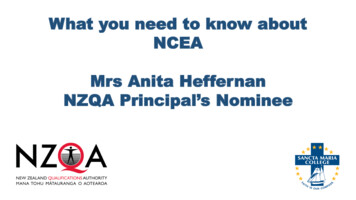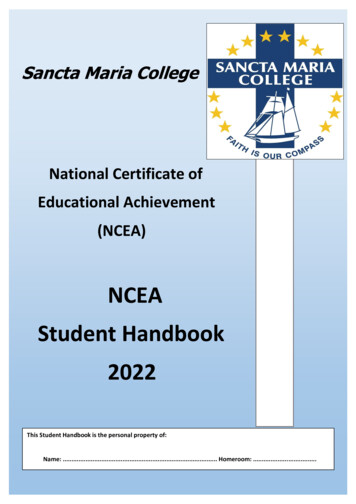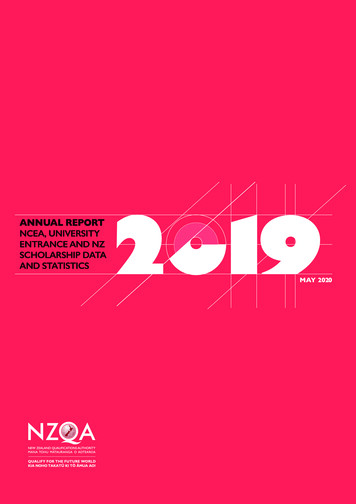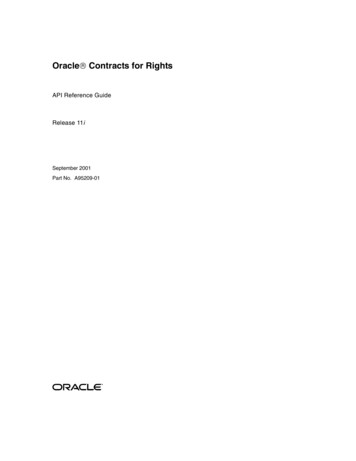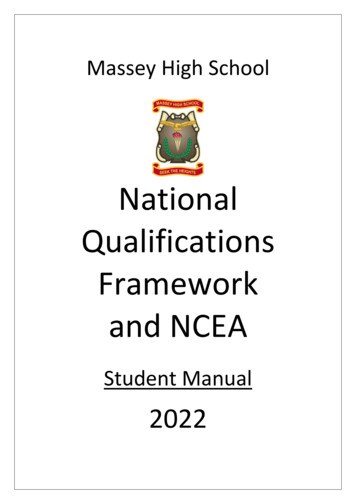
Transcription
NCEA ChangePackage 2019OverviewHave your say aboutthe future of education.Join the conversation at AReview#EdConvo
NCEA CHANGE PACKAGE 2019 OVERVIEWCrown copyright May 2019ISBN Print: 978-1-77669-656-7ISBN2 Online: 978-1-77669-657-4
NCEA CHANGE PACKAGE 2019 OVERVIEWContents1. Introduction .5a. What's happened so far?. 5b. What next?. 52. NCEA Change package.61. Make NCEA more accessible . 62. Mana Ōrite mo te Mātauranga Māori . 73. Strengthen literacy and numeracy requirements. 84. Have fewer, larger standards. 105. Simplify NCEA’s structure.126. Show clearer pathways to further education and employment. 147. Keep NCEA Level 1 as an optional level. 163. How an NCEA programme could look. 184. Purpose and outcome statements. 20a. Strategic Purpose statement/ Te rautaki o te tohu. 20b. A qualification outcome statement Graduate Profile/Ngā hua o te tohu.21c. Education Pathway (Ngā huarahi mātauranga) / Employment, Cultural,Community Pathway (Ko ngā huarahi ā-mahi, ā-ahurea, ā-whānau, ā-hapū, ā-iwi,ā-hapori anō hoki).215. Timeline.226. Conclusion .24a. Where to find other important information.247. Glossary.25PC2019023
NCEA CHANGE PACKAGE 2019 OVERVIEW4
NCEA CHANGE PACKAGE 2019 OVERVIEW1. IntroductionThe purpose of this document is to provide detail on thechange package to NCEA following the public engagement.a. What's happened so far?In 2018, the Minister of Education launched a nationalconversation on the future of NCEA. As part of this, we asked allNew Zealanders to share their views and experiences of NCEA– the challenges, the successes, what they like, and what we cando better. We wanted to make sure that everyone’s voice wouldbe heard.Using what we heard, along with data and evidence, theMinisterial Advisory Group, the Professional Advisory Group andthe Ministry of Education provided advice to the Minister onrecommended changes to NCEA, based on the findings of the2018 engagement phase.The Government has now announced the change packagewhich has resulted from this engagement. These changes areoutlined in more detail in this document.b. What next?The Ministry will now work with key stakeholders on thedetailed design of these changes as well as to understand theimplementation implications.For further information about these changes, please -say or contactthe Ministry at NCEA.Review@education.govt.nz.5
NCEA CHANGE PACKAGE 2019 OVERVIEW2. NCEA Change package11. Make NCEA more accessibleWhat did we hear?We have been told the current design of NCEAcreates barriers to access for many New Zealandersworking towards the qualification.Special Assessment Conditions (SAC) provideextra help for approved students when they arebeing assessed for their NCEA, allowing them a fairopportunity to achieve.The process of applying for SACs can be difficult andoften deters students from applying in the first place.Along with NCEA fees, the design of assessmentsdisadvantage some of our most vulnerable students,making NCEA hard to access.Key changes End NCEA fees and fees for NZ Scholarship Design achievement standards to beaccessible for all, so that students withdisabilities and students with learning supportneeds have equal opportunity to achieve Where possible, make some existing SACsavailable to anyone For other forms of SAC, simplify theapplication and evaluation process wherepossible.6What you need to knowThere will be an end to all NCEA fees, includingfor NZ Scholarship examinations (which currentlyhave very low rates of participation in lowdecile schools). Removing all domestic feeswill ensure students receive their qualificationand are able to access their chosen learning oremployment pathway. It will also make NCEA lessadministratively difficult for schools, whānau, andstudents than under the status quo.The design of assessments will be improved, sothat SACs are required in fewer cases but areavailable as part of everyday teaching and learning.We will make some existing SACs more readilyavailable for all where possible (e.g. larger-printpapers).Where SACs cannot be extended to all conditions,we will work with users and experts to ensure theprocess is as simple and low-cost as possible.Through the review of achievement standards, wewill modify assessment standards, teaching andlearning guides, and exemplar programmes andassessment resources, to ensure they exemplifyinclusive practice (including for languages, cultures,identities, disabilities, genders, and sexualities).
NCEA CHANGE PACKAGE 2019 OVERVIEW2 Mana Ōrite mo te Mātauranga MāoriWhat did we hear?Māori respondents expressed their concerns aroundan NCEA system that is not equitable for Māori, anddisadvantages too many students from experiencingsuccess as Māori. It is fundamental that there isparity for mātauranga Māori within NCEA, and it hasequal value to other bodies of knowledge.Key changes Integrate te ao Māori and mātauranga Māoriinto the outcome statements as part of thenew ‘graduate profile’ for NCEA and in thedesign of achievement standards Ensure equal support for ākonga Māori inall settings and equal status for mātaurangaMāori Develop more standards to make sure thatmātauranga Māori is acknowledged andcredentialed equally by NCEA, (e.g. MāoriPerforming Arts)›› inclusive standards and assessmentresources that allow for diverse culturalperspectives on what’s important e.g.considering community or hapū impact, notjust individual user needs›› Build teacher capability around culturallyinclusive NCEA and assessment andaromatawai practice that is respectful tomātauranga Māori.What you need to know We want to ensure there is equal status formātauranga Māori in NCEA, and that greateropportunities for students to follow mātaurangaMāori pathways are available. We will work closely with Māori – in both Māorimedium and English medium education and in thewider community, including iwi, hapū and whānau– to design what this looks like in practice. Develop new assessment resources andteaching and learning guides for mātaurangaMāori Ensuring that, where possible andappropriate, te ao Māori and mātaurangaMāori are built into achievement standardsfor use across English and Māori-mediumsettings. That might mean:›› having Māori-centred contexts forexemplars and assessment resources e.g.local iwi history7
NCEA CHANGE PACKAGE 2019 OVERVIEW3 Strengthen literacy andnumeracy requirementsWhat did we hear?We heard strongly through engagement that manystudents are leaving school without the levels ofliteracy and numeracy necessary to engage with thecommunity, further education and work.The current literacy and numeracy requirements arenot assessed to the same benchmark. As a result,students often come out of NCEA without reliablelevels of literacy and numeracy, with some studentsunable to reach the standards needed for futuresuccess. This has affected NCEA’s credibility.We heard it is important teachers are given thesupport and tools needed to make sure students aremaking sufficient progress in literacy and numeracy,and to effectively intervene if learners are notmaking expected progress. It is important thesestudents are identified early-on.Employers and tertiary education organisationsneed more confidence that the NCEA literacy andnumeracy requirements are reliable and credible.Key changes We will develop standards for Literacy andNumeracy which make up a coherent packageof 20 credits The new literacy and numeracy requirementwill be a co-requisite to NCEA Students will be able to meet the standardwhenever they are ready, which may be asearly as Year 7 The credits will not contribute to the new 60credit requirements for each level of NCEA The standards will be externally graded, toavoid increasing teacher workload and toguarantee credibility.8What you need to knowWe will set a single common benchmark in Englishand Te Reo, to assess a student’s literacy andnumeracy skills. The benchmark will provide a clearstandard to evaluate performance and level ofquality across literacy and numeracy.The single common benchmark must be met togain any level of NCEA and can be assessed againstwhenever students are ready.We will develop tools for teachers and tertiaryeducators to make good, valid judgment's aboutliteracy and numeracy.
NCEA CHANGE PACKAGE 2019 OVERVIEW9
NCEA CHANGE PACKAGE 2019 OVERVIEW4 Have fewer, larger standards4.What did we hear?We have been told that NCEA is becomingincreasingly disconnected and the number ofstandards in some subjects has grown significantlyover time. Many subject areas offer many morecredits than would make up a reasonable course– meaning that it can be hard to identify the mostimportant learning, which can significantly increaseteacher and student workload.We have heard that the sheer volume of design,delivery, marking, moderation and reassessmentwork across numerous internal assessments per yearcan be overwhelming.We have heard fewer, larger achievement standardsand a clearer understanding for students, teachersand whānau about what students are learning, willbetter capture the key competencies and skillsneeded for young people to succeed.Key changes Rebuild the achievement standards within eachsubject or field of study so there are fewerof them, but each standard covers a broaderrange of knowledge Re-balance the number of credits available forinternally and externally assessed achievementstandards (50:50 split) Achievements standards assessed externallywill include exams and other forms ofassessment, including portfolios. Integrate different sources of knowledge fromthe National Curriculum, into achievementstandards, unit standards and associatedmaterials Strengthen industry-derived standards (as partof the Reform of Vocational Education (RoVE)to support the development of high qualityand coherent vocational learning packageswithin NCEA Expand course endorsements to includeAchieved as well as Merit and Excellencegrades. Require a brief course description for allregistered courses.What you need to knowThe sets of standards within each subject or field ofstudy will be rebuilt so that teachers are empoweredto design quality programmes of learning, focusingon coherent blocks of the most important learning.Through the review of achievement standards: The size of standards will be made consistent,likely between 4 and 6 credits, rather than thecurrent 2 to 8 range. The maximum size of NCEA subjects and fieldsof study will be reduced to around 20 credits persubject.10
NCEA CHANGE PACKAGE 2019 OVERVIEW The number of credits available between internallyand externally assessed achievement standards willbe rebalanced. We are aiming for an approximate50:50 split. Different sources of knowledge, includingmātauranga Māori, vocational learning and Pacificpeoples knowledge will be reflected in achievementstandards, unit standards and associated materials. Teacher capability will be built to incorporatemātauranga Māori and more Pacific knowledge(where appropriate), into teaching under NCEA.Providing guidance on contextualising task designfor learning support, disabled peoples and diversestudent backgrounds, identities, languages andculture.There will be opportunities to strengthen the qualityand status of Vocational Education Training withinNCEA by: Involving employers and bodies responsiblefor setting industry standards in the review ofachievement standards, to ensure achievementstandards can support vocational learning. As part of the RoVE, working in partnership withindustry standard-setting bodies, schools and otherproviders offering NCEA, review how learningtowards industry-derived standards could be betteraligned to NCEA and the National Curriculum. Supporting schools and foundation tertiaryeducation organisations to deliver high quality andcoherent pathways for all students by designingcurriculum tools to support ‘academic’ as well asvocational learning.Course endorsements will be expanded to recogniseattainment at Achieved level and to include coursesassessed with industry-based standards.The brief course description will signal what thatcourse focuses on, and how it might fit in to thestudent’s future pathway and overall learning. This willimprove the coherence of courses and give employersand tertiary providers a clearer indication of what astudent knows and can do.11
NCEA CHANGE PACKAGE 2019 OVERVIEW5 Simplify NCEA’s structure5.What did we hear?We have heard that the credit structure of NCEAcan be unclear and the carry-over of credits fromone level to the next causes confusion to the overallunderstanding of NCEA.We have also heard strongly that NCEA createsworkload issues for students and teachers.Contributors to the workload include: the focus on accumulating credits; the number of assessment tasks; and pressure to allow multiple resubmissions (allowinga student a short period of time to correct minorerrors which have prevented the awarding of ahigher grade), sometimes outside the intendedscope of the rules.Key changes Remove credits 'carried over' from the levellower and used for more than one certificate Make each Level of NCEA a 60 creditqualification Clear guidance provided on the number ofcredits students should enter each year; 120credits for Levels 1 and 2, 100 credits for Level3 Only allow resubmissions that take a studentfrom a Not Achieved to an Achieved grade.12What you need to knowThe ‘carry over’ of credits will be removed and thenumber of credits required for each level of NCEAwill be set at 60.Guidance will be introduced indicating that moststudents should attempt no more than 120 creditsat Level 1 and 2, and 100 credits at Level 3. Wheneach course is rebuilt as a coherent suite of 4 or 5standards, worth about 20 credits, students takingup to 5 or 6 courses per year would not exceed thiscredit limit. In the short term, we would develop newTeaching and Learning Guides to support teachersto build courses from existing standards while newstandards are developed.Schools would only offer a resubmission opportunityto students where a minor error prevents them fromreaching the ‘achieved’ grade (not for merit andexcellence). This would not affect the provision offurther assessment opportunities (a furtherassessment for the same standard using a newassessment task, after further learning has takenplace).
NCEA CHANGE PACKAGE 2019 OVERVIEW13
NCEA CHANGE PACKAGE 2019 OVERVIEW6 Show clearer pathways to further6.education and employmentWhat did we hear?Students do not always get access to clear, qualitypathways, or the information to be able to makegood decisions about their future. As a result,students can end up taking subjects which do notset them up with a deliberate pathway to their nextstep, preventing them transitioning successfully tofurther education and employment and making itdifficult for them to achieve their aspirations. Thereare a range of pathways into further VET, and thiscan be confusing to navigate.A key strength of NCEA is its ability to recogniseCurriculum–related learning as well as industryrelevant knowledge, skills and capability. However,we heard concerns about the credibility of some unitstandards, and vocational learning is often perceivedas a less attractive learning option.There is a need for the purposes of each NCEA levelto be made clearer for students and whānau, so theycan make more informed decision-making in relationto NCEA. Parents and employers thought the Recordof Achievement (RoA) was difficult to understand.What you need to know‘Graduate profile’»» A ‘graduate profile’ will be developed as part of a set of‘outcome statements’ for each NCEA qualification.»» This will include a clear description of what a personawarded the qualification must be able to do and know.The minimum expectation is that any one level of thequalification should prepare the graduate to undertakestudy at the next level of qualification.»» The graduate profile will list clear purpose and outcomestatements aligned with the characteristics for thatparticular graduate (and level of qualification). Theseshould clearly communicate the expectations ondesigning and delivering the curriculum. The tools wepropose to develop through the revised assessmentstandards will support the content of these statementsfurther.»» Integrate te ao Māori and mātauranga Māori into theoutcome statements for NCEA in discussion with Māorieducationalists, iwi and hapū.»» Within each graduate profile, the list of outcomestatements will provide associated education,employment, cultural and community pathways,outlining further learning a graduate of the qualificationcan undertake.»»Key changes Create 'graduate profiles' for each level ofNCEA, which offer young people a breadth ofcourses but with opportunities to specialise Develop a Vocational Entrance (VE) Awardfor students to directly enter higher-levelVET, and to more easily build high quality andcoherent packages of vocational learning inschool and foundation tertiary education Refine the RoA to be clearer and moresummative in what the student has achievedin their NCEAs14The graduate profiles, purpose and outcome statements areavailable in section 4.Vocational Entrance (VE) AwardWe plan to explore how to better shape packages ofvocational learning for schools and foundation tertiaryproviders, including how to recognise excellence andachievement in vocational education. As part of theRoVE, we want to develop a Vocational EntranceAward.A VE Award will be developed to sit alongsideNCEA Level 3. It will play a similar role to UniversityEntrance (UE) signaling that a student has undertakenthe requisite foundation tertiary learning valuedby industry, employers and Tertiary EducationOrganisations (TEO), and is ready for direct entry
NCEA CHANGE PACKAGE 2019 OVERVIEWinto higher-level VET at Level 4 and above. This willhelp to reposition vocational education as a valuedpathway for students leaving secondary school andfoundation tertiary education.The specific design of the award and relatedprogrammes of study will be subject to furtherdevelopment, including consultation with industrystandards-setting bodies, as well as school andtertiary sectors. This will also include considerationof any common and industry-specific requirements.In the interim, we will explore ways to strengthenthe Vocational Pathways by applying the sameprinciples as applied to the achievement standardsreview to supporting unit standards commonlydelivered in schools.Record of Achievement (RoA)There will be a light-touch redesign of the RoAwhich will include an expanded summary page toquickly show a student’s key achievements. Thepage will include: The NCEAs they have achieved, including courseendorsements. Course endorsements at Achieve, Merit andExcellence. A series of brief course descriptions.15
NCEA CHANGE PACKAGE 2019 OVERVIEW77. Keep NCEA Level 1 as an optional levelWhat did we hear?Last year, we had lots of conversations aboutwhether or not to keep NCEA Level 1.We heard that, for many students, Level 1 is a vitalpart of NCEA. It introduces them to the format ofNCEA assessment and prepares them for their nextstep. Many school leaders wanted to keep Level 1 asit keeps their students motivated by giving them agoal to work towards. Māori and Pacific people toldus that they also value Level 1 highly.For around 10% of students, NCEA Level 1 will betheir highest level qualification. Removing it as anoption has the potential to disadvantage this groupof students.Others have suggested that removing Level 1 willallow teachers to focus more on teaching and less onassessment. By reducing their assessment workload,teachers would be free to develop innovativeapproaches to Year 11 which would be of more valueto students than a Level 1 qualification.16What you need to knowWe want to keep NCEA Level 1 as an optional levelfor those schools and communities that feel it wouldbe of value for them. Others would be free to adoptalternative approaches to Year 11, in a way that bestmeets the needs of their students.As part of our rebuild of NCEA standards, Level 1 willbe refocused on a broad education across a widerange of Learning Areas Wāhanga Ako. We willwork closely with teachers and subject associationsto build these standards.Through this process, we want to explore ways thatstudents can access opportunities to credential awider variety of content, such as extracurricularactivities, strengths and skills, or work experience, aspart of their NCEA.
NCEA CHANGE PACKAGE 2019 OVERVIEW17
NCEA CHANGE PACKAGE 2019 OVERVIEW3. How an NCEAprogramme could look*This illustration is intended as a visual aid to show how an NCEA programme could lookin the future. All standards and credit values are indicative only.Through the review of achievement standards, we will rebuild the standards within eachsubject. Each subject will have around 4-5 available standards (around 20 credits).Literacy and Numeracy requirement - 20 credits (all external)ZZ Students will need to achieve these standards to be awarded any level of NCEAZZ Co-requisite (does not contribute to the 60 credit requirement)ZZ Students are able to be assessed when ready from year 7Level 1A broad educationunderpinned by a foundationexploration of a range of disciplinesFull year programme of up to 6subjects – 120 credits. 60 level 1credits required to be awarded level 1Level 2Promote more specialisation, deeperdisciplinary knowledge and skills, andreadiness to transition to furthereducation and the world of workFull year programme of up to 6subjects – 120 credits. 60 level 2credits required to be awarded level 2Level 3Promote more specialisation, deeperdisciplinary knowledge and skills andreadiness to transition to furthereducation and the world of workFull year programme of up to 5subjects – 100 credits. 60 level 3credits required to be awarded level 3Record ofAchievement18Subject 2 (e.g. Science)Subject 1 (e.g. Te Reo Māori)20 credits from AchievementStandards20 credits from AchievementStandards6 CreditInternal6 CreditExternal6 CreditInternal6 CreditExternal4 CreditExternal4 CreditInternal4 CreditExternal4 CreditInternalSubject 1 (e.g. Te Reo Māori)20 credits from AchievementStandardsSubject 2 (e.g. Physics)20 credits from AchievementStandards6 CreditInternal6 CreditExternal6 CreditInternal6 CreditExternal4 CreditExternal4 CreditInternal4 CreditExternal4 CreditInternalSubject 1 (e.g. Te Reo Māori)20 credits from AchievementStandardsSubject 2 (e.g. Physics)20 credits from AchievementStandards6 CreditInternal6 CreditExternal5 CreditInternal5 CreditExternal4 CreditExternal4 CreditInternal5 CreditExternal5 CreditInternalCertificate Endorsement- NCEA Level 1 achieved with merit- NCEA Level 2 achieved with merit- NCEA Level 3 achieved withexcellenceCourse Endorsements(with brief course description)-Physics level 2 endorsed with achievementTe Reo Māori level 3 endorsed with excellencePhysics level 3 endorsed with meritMaths level 3 endorsed with excellence
NCEA CHANGE PACKAGE 2019 OVERVIEW4 CreditExternalSubject 3 (e.g. English)20 credits from AchievementStandards6 CreditExternal6 CreditExternal4 CreditExternalSubject 4 (e.g. PE)20 credits from AchievementStandardsSubject 5 (e.g. Maths)20 credits from AchievementStandardsSubject 6 (e.g. Health)20 credits6 CreditInternal6 CreditExternal6 CreditInternal6 CreditExternal5 CreditInternal5 CreditExternal6 CreditInternal6 CreditExternal4 CreditExternal4 CreditInternal4 CreditExternal4 CreditInternal5 CreditExternal5 CreditInternal4 CreditExternal4 CreditInternalSubject 3 (e.g. English)20 credits from AchievementStandardsSubject 4 (e.g. FoodTechnology) 20 credits fromAchievement StandardsSubject 5 (e.g. Maths)20 credits from AchievementStandards6 CreditInternal6 CreditExternal5 CreditInternal5 CreditExternal6 CreditInternal5 CreditExternal4 CreditExternal4 CreditInternal6 CreditExternal4 CreditInternal5 CreditExternal5 CreditInternalSubject 3 (e.g. English)20 credits from AchievementStandardsSubject 4 (e.g. Health)20 credits from AchievementStandards6 CreditInternal6 CreditExternal5 CreditInternal5 CreditExternal4 CreditExternal4 CreditInternal6 CreditExternal4 CreditInternalSubject 6 (e.g. building andconstruction) 20 credits fromUnit Standards20 credits froma number of unitstandardsSubject 5 (e.g. Hospitality)20 credits from Unit Standards20 credits froma number of unitstandardsVocational Entrance AwardTo signal that a student has undertakenfoundation tertiary learning valued byindustry, employers and TEOs, and is readyfor direct entry into higher-level VET.University Entrance AwardAnd / OrStudents gain sufficient credits from the listof UE approved NCEA subjects to meet therequirements for entrance to University.19
NCEA CHANGE PACKAGE 2019 OVERVIEW4. Purpose andoutcome statementsAs part of registering a reviewed NCEA on the New ZealandQualifications Framework, we will develop new purposeand outcome statements for each level of NCEA. Thesewill indicate what students working towards an NCEA canexpect to learn - what the characteristics, knowledge, skillsand capabilities of an NCEA graduate are - and what nextsteps an NCEA might lead to.The draft purpose and outcome statements are designedto reflect the change package above. Where appropriate,te ao Māori and mātauranga Māori will be included inthe statements and designed in discussion with Māorieducationalists, iwi and hapū.a. Strategic Purpose statement/ Te rautaki o te tohuPurposestatementNCEA Level 1NCEA Level 2NCEA Level 3NCEA Level 1 is an open-fieldqualification, which qualifieslearners with basic knowledgeand skills aligned to Level 6 of theNational Curriculum and literacyand numeracy capabilities for life,employment and further study.NCEA Level 2 is an open-fieldqualification, which qualifieslearners with knowledge, skills,and capabilities aligned to level 7of the National Curriculum.NCEA Level 3 is an open-fieldqualification, which qualifieslearners with knowledge, skills,and capabilities aligned to level 8of the National Curriculum.This qualification recognisesa broad range of educationoutcomes that prepare learnersfor further education at Level 3of the New Zealand QualificationFramework and employmentpathways.This qualification recognisesa broad range of educationoutcomes that prepare learnersfor further education at Level 4and beyond of the New ZealandQualifications Framework.This qualification recognisesa broad range of educationoutcomes that prepare learnersfor further education at Level 2of the New Zealand QualificationFramework where the focus shiftstowards transitions or furtherspecialisation.Graduates of this qualificationhave engaged in a broad andholistic education. Throughexperiencing achievementsuccess in meaningful contexts,graduates are enabled tocontinue on a learning pathway.20Graduates of this qualificationhave engaged in a broadand holistic education withopportunities to specialise.Through experiencingachievement success inmeaningful contexts, graduatesare enabled to continue on alearning pathway or a range ofemployment pathways.Graduates of this qualificationhave engaged in a broadand holistic education withopportunities to specialise.Through experiencingachievement success inmeaningful contexts, graduatesare enabled to continue on atertiary learning pathway ora wide range of employmentpathways.
NCEA CHANGE PACKAGE 2019 OVERVIEWb. A qualification outcome statement Graduate Profile/Ngā hua o te tohuGraduateprofileknowledgeNCEA Level 1NCEA Level 2NCEA Level 3Graduates of thisqualification will be able to:Graduate of this qualification willbe able to:Graduate of this qualification will beable to:Demonstrate foundationknowledge in a range ofcurriculum areas.Demonstrate knowledgeand emerging conceptualunderstanding of severalcurriculum areas.Demonstrate a knowledge of coreconcepts in several discipline areas.Demonstrate emergent awarenessof how disciplinary knowledge iscreated and validated.Graduateprofilecompetencies /capabilitiesDemonstrate functionalliteracy and numeracy anda basic understan
Along with NCEA fees, the design of assessments disadvantage some of our most vulnerable students, making NCEA hard to access. Key changes End NCEA fees and fees for NZ Scholarship Design achievement standards to be accessible for all, so that students with disabilities and students with learning support
